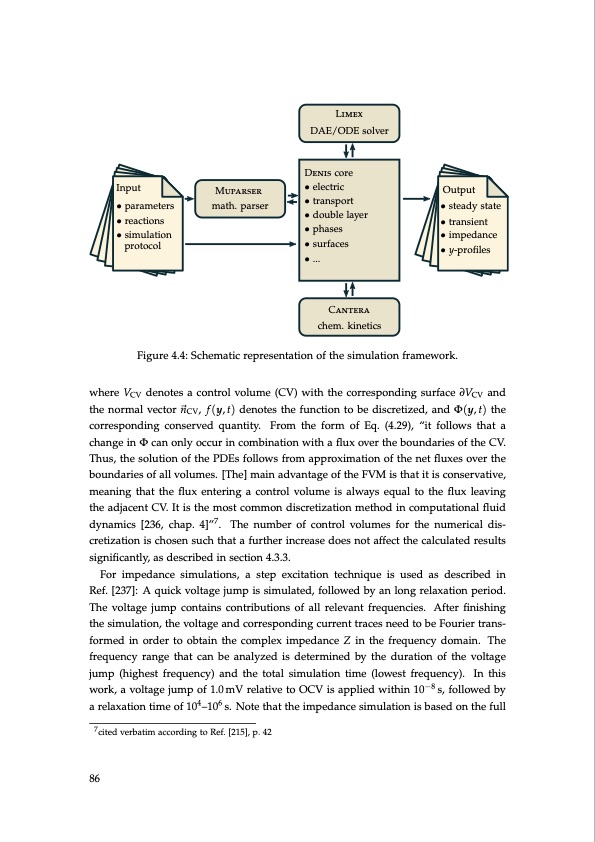
PDF Publication Title:
Text from PDF Page: 086
Limex DAE/ODE solver Denis core • electric • transport • double layer • phases • surfaces • ... Input • parameters • reactions • simulation protocol Muparser math. parser Output • steady state • transient • impedance • y-profiles Figure 4.4: Schematic representation of the simulation framework. where VCV denotes a control volume (CV) with the corresponding surface ∂VCV and the normal vector ⃗nCV, f (y, t) denotes the function to be discretized, and Φ(y, t) the corresponding conserved quantity. From the form of Eq. (4.29), “it follows that a change in Φ can only occur in combination with a flux over the boundaries of the CV. Thus, the solution of the PDEs follows from approximation of the net fluxes over the boundaries of all volumes. [The] main advantage of the FVM is that it is conservative, meaning that the flux entering a control volume is always equal to the flux leaving the adjacent CV. It is the most common discretization method in computational fluid dynamics [236, chap. 4]”7. The number of control volumes for the numerical dis- cretization is chosen such that a further increase does not affect the calculated results significantly, as described in section 4.3.3. For impedance simulations, a step excitation technique is used as described in Ref. [237]: A quick voltage jump is simulated, followed by an long relaxation period. The voltage jump contains contributions of all relevant frequencies. After finishing the simulation, the voltage and corresponding current traces need to be Fourier trans- formed in order to obtain the complex impedance Z in the frequency domain. The frequency range that can be analyzed is determined by the duration of the voltage jump (highest frequency) and the total simulation time (lowest frequency). In this work, a voltage jump of 1.0 mV relative to OCV is applied within 10−8 s, followed by a relaxation time of 104–106 s. Note that the impedance simulation is based on the full 7cited verbatim according to Ref. [215], p. 42 Cantera chem. kinetics 86PDF Image | Lithium-Sulfur Battery: Design, Characterization, and Physically-based Modeling

PDF Search Title:
Lithium-Sulfur Battery: Design, Characterization, and Physically-based ModelingOriginal File Name Searched:
Dissertation_David_N._Fronczek_The_Lithium_Sulfur_Battery.pdfDIY PDF Search: Google It | Yahoo | Bing
Sulfur Deposition on Carbon Nanofibers using Supercritical CO2 Sulfur Deposition on Carbon Nanofibers using Supercritical CO2. Gamma sulfur also known as mother of pearl sulfur and nacreous sulfur... More Info
CO2 Organic Rankine Cycle Experimenter Platform The supercritical CO2 phase change system is both a heat pump and organic rankine cycle which can be used for those purposes and as a supercritical extractor for advanced subcritical and supercritical extraction technology. Uses include producing nanoparticles, precious metal CO2 extraction, lithium battery recycling, and other applications... More Info
| CONTACT TEL: 608-238-6001 Email: greg@infinityturbine.com | RSS | AMP |